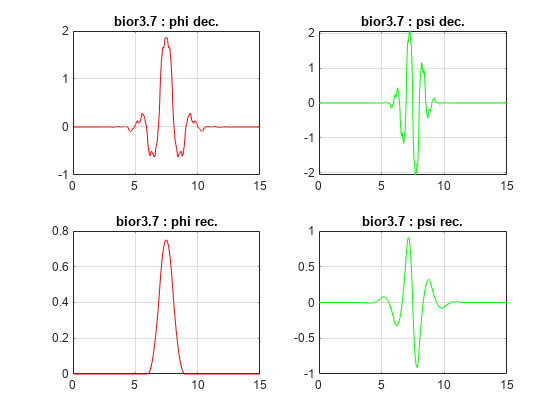wavefun
Wavelet and scaling functions
Syntax
Description
[
returns phi,psi,xval] = wavefun(wname,iter)psi and phi, approximations of
the wavelet and scaling functions, respectively, associated with the orthogonal
wavelet wname, or the Meyer wavelet. The approximations are
evaluated on the grid points xval. The positive integer
iter specifies the number of iterations
computed.
[
returns approximations of the wavelet and scaling functions associated with the
biorthogonal wavelet phi1,psi1,phi2,psi2,xval] = wavefun(wname,iter)wname. The wavelet and scaling
function approximations psi1 and phi1,
respectively, are for decomposition. The wavelet and scaling function
approximations psi2 and phi2,
respectively, are for reconstruction.
[___] = wavefun(___,"plot") also
plots the functions.
Examples
Input Arguments
Output Arguments
Algorithms
For compactly supported wavelets defined by filters, in general no closed form analytic formula exists.
The algorithm used is the cascade algorithm. It uses the single-level inverse wavelet transform repeatedly.
Let us begin with the scaling function ϕ.
Since ϕ is also equal to ϕ0,0, this function is characterized by the following coefficients in the orthogonal framework:
<ϕ, ϕ0,n> = 1 only if n = 0 and equal to 0 otherwise
<ϕ, ψ−j,k> = 0 for positive j, and all k.
This expansion can be viewed as a wavelet decomposition structure. Detail coefficients are all zeros and approximation coefficients are all zeros except one equal to 1.
Then we use the reconstruction algorithm to approximate the function ϕ over a dyadic grid, according to the following result:
For any dyadic rational of the form x = n2−j in which the function is continuous and where j is sufficiently large, we have pointwise convergence and
![]()
where C is a constant, and α is a positive constant depending on the wavelet regularity.
Then using a good approximation of ϕ on dyadic rationals, we can use piecewise constant or piecewise linear interpolations η on dyadic intervals, for which uniform convergence occurs with similar exponential rate:
![]()
So using a J-step reconstruction scheme, we obtain an approximation that converges exponentially towards ϕ when J goes to infinity.
Approximations are computed over a grid of dyadic rationals covering the support of the function to be approximated.
Since a scaled version of the wavelet function ψ can also be expanded on the (ϕ−1,n))n, the same scheme can be used, after a single-level reconstruction starting with the appropriate wavelet decomposition structure. Approximation coefficients are all zeros and detail coefficients are all zeros except one equal to 1.
For biorthogonal wavelets, the same ideas can be applied on each of the two multiresolution schemes in duality.
Note
This algorithm may diverge if the function to be approximated is not continuous on dyadic rationals.
References
[1] Daubechies, I. Ten Lectures on Wavelets. CBMS-NSF Regional Conference Series in Applied Mathematics. Philadelphia, PA: Society for Industrial and Applied Mathematics, 1992.
[2] Strang, G., and T. Nguyen. Wavelets and Filter Banks. Wellesley, MA: Wellesley-Cambridge Press, 1996.
Version History
Introduced before R2006a



